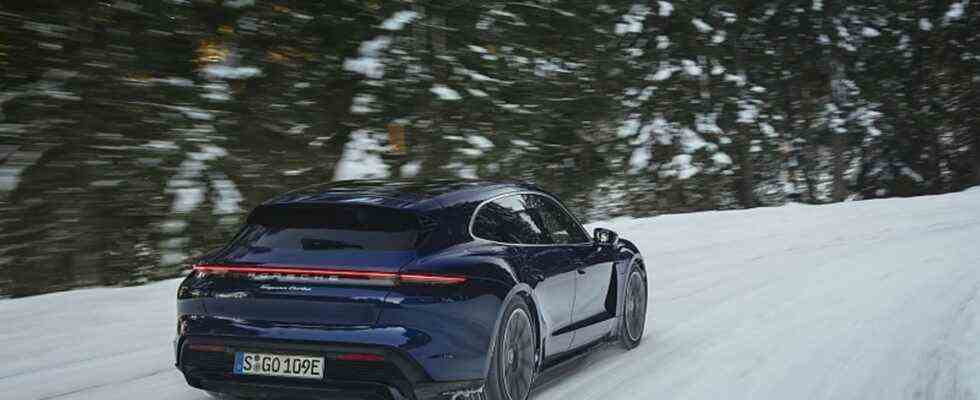Porsche Taycan Turbo Sport Turismo
gap closer
Porsche Taycan Turbo Sport Turismo
© press-inform – the press office
After the limousine and the Cross Turismo, Porsche is launching another model variant of the electric sports car with the Taycan Spot Turismo. In addition to a lowering of the body, what is particularly exciting is what has happened in the drive technology.
Then you understand the car manufacturers. On the one hand, they complain about the money-consuming wealth of variants, so they want to thin out the model range and now Porsche is bringing the third Taycan variant onto the market with the Sport Turismo. And then another where the body is two centimeters lower than the crossover Taycan. “The new derivative is aimed at those who want to combine the everyday suitability of the Taycan Cross Turismo with the “on-road” dynamics of the Taycan sports sedan,” says Porsche. Aha. After all, the station wagon or Shooting Brake is a handsome car.
We grabbed the Taycan Turbo Sport Turismo and immediately took a look at the price list. The station wagon costs at least 153,968 euros and is therefore almost 500 euros cheaper than the crossover. So if you can do without the indicated underbody protection, the wheel arches in off-road optics and the higher body, you save money. A fundamental difference becomes clear in the entry-level model: while the Cross Turismo is only available with all-wheel drive, Porsche offers the Sport Turismo as a pure rear-wheel drive vehicle. It somehow suits Porsche and with 240 kW / 326 hp continuous power (300 kW / 408 hp boost) you are definitely not underpowered and at 86,495 euros you put significantly less on the table. If you consider the additional equipment, the price difference is put into perspective a bit. It starts with the battery: while the basic version is available with the “small” 79.2 kilowatt hour battery pack, the Turbo always has the “Performance Battery Plus” with a gross capacity of 93.4 kWh (83.7 kWh net). installed. This is accompanied by a maximum charging capacity of 270 kW compared to 225 kW for the basic battery.
The Taycan Turbo Sport Turismo with its continuous output of 460 kW / 625 and boost 500 / 680 hp is in a completely different position. With this boost, the Taycan Turbo Sport Turismo breaks the 100 km/h mark after 3.2 seconds and then storms on to 260 km/h. The difference in driving dynamics to the somewhat higher-legged crossover brother is basically negligible, as soon as you approach the limit area, the Sport Turismo acts a bit more neutrally due to its lower center of gravity. So this Taycan is also a lot, a lot of fun, especially when you’re driving on snow-covered roads. The driving modes remain unchanged. Fun pilots let the rear run a little more with Sport Plus, the brave deactivate the ESP. The good and comfortable seats are the same as in the sister models, offer lateral support, are comfortable and therefore suitable for long journeys.
This brings us to the topic of consumption and, above all, range. The Taycan Turbo Sport Turismo treats itself to an average of 24.2 kWh per 100 kilometers and has a range of up to 491 kilometers (WLTP). The range king in the Sport Turismo series is the 4S version with up to 498 kilometers when the large battery is installed. Especially since you are well positioned with this model with a maximum of 390 kW / 530 hp. The improvements in range go hand in hand with an optimization of the drive train and the interaction of the two electric motors. The lever that the technicians use is the software. Basically, the all-wheel drive of the Taycan 4 models is an “on-demand” version of the drive. Thanks to new algorithms, the two PSM motors (permanently excited synchronous machines) can be switched off within 100 microseconds and put back into operation just as quickly.
As soon as possible, the system now disconnects the front electric motor from the mains and no longer the rear machine, as was previously the case. This is the case, for example, on the motorway or country roads when the route profile is flat and you are going straight ahead. The fast response time with which the electric motors can be switched on and off opens up even more optimization options in other driving situations. If it goes even slightly downhill or if the driver takes his foot off the accelerator, both engines say goodbye and the Taycan glides along. The lightning-fast action also helps in stop-and-go traffic, because here too, both electric motors are imperceptibly switched on and off again in fractions of a second. Finally, the question remains as to why the Taycan 4S Sport Turismo is the range master of the model series and not the purely rear-wheel drive basic variant. The reason is simple: It is more efficient to operate two electric machines, each with 50 percent of the maximum power, than to fully exhaust one.
As expected, the Sport and the Cross Turismo don’t sacrifice anything when it comes to space. Due to the changed roof line, the two model variants offer 45 millimeters more headroom, which makes a clear difference, since adults taller than 1.85 meters do not have to duck their heads. Those who opt for the glass panorama roof gain another two millimeters . That doesn’t change the fact that the legroom doesn’t necessarily have to be in XXL format. The same goes for the trunk, which is decent with a capacity ranging from 405 to 1,171 liters. After all, there is still a “frunk” for small items, i.e. a luggage compartment in the front, in which an additional 84 liters fit.


